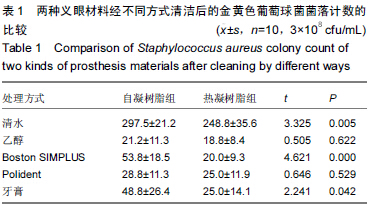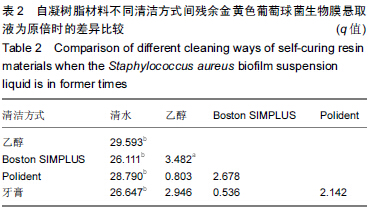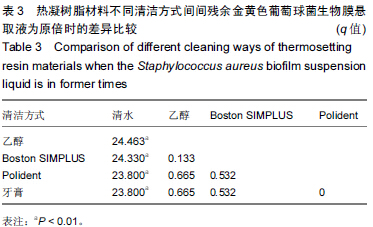[1] Pine K,Sloan B, Stewart J, et al. Concerns of anophthalmic patients wearing artificial eyes. Clin Experiment Ophthalmol. 2011;39(1):47-52.
[2] 杨新,宋岩,王凡涛,等.高分子义眼材料表面的粗糙度及硬度[J].中国组织工程研究,2014,18(8):1257-1259.
[3] 高方,高利雅,宋斗,等.聚甲基丙烯酸甲酯义眼片在眼球缺失美容中的应用[J].中华医学美学美容杂志,2006,12(2):68-79.
[4] 金晖博,张莹.眼外伤等眼外形破坏时PMMA义眼的整容效果[J].眼外伤职业眼病杂志,2004,26(6):401-403.
[5] Song JS,Oh J,Baek SH.A survey of satisfaction in anophthalmic patients wearing ocular prosthesis.Graefes Arch Clin Exp Ophthalmol.2006;244(3):330-335.
[6] 杨砚廷,卢国华.应用抗菌药物降低结膜囊细菌量的临床研究[J].中国感染质控杂志,2014,13(11):674-676.
[7] Ryu M,UedaT,Saito T,et al. Oral environmental factors affecting number of microbes in saliva of complete denture wearers.J Oral Rehabil.2010;37(3):194-201.
[8] Byeth N,Bahir R,Matalon S,et al.Streptococcus mutans biofilm changes surface-topography of resin composites.Dent Mater. 2008;24(6):732-736.
[9] 丁连花.儿童活动义眼片的临床应用及分析[J].山东医学高等专科学校学报,2011,33(6):428-429.
[10] 张津,王海莹,薛园园,等.仿真义眼片的制作应用及护理[J].齐鲁护理杂志,2012,18(32):63-64.
[11] 易敬林,许小毛,卢屹.仿真硬性薄义眼片的定制技术和临床应用[J].江西医药,2006,41(1):1-2.
[12] 游素兰,吴伟恂,蒋永林,等.一种新眼眶赝复体与常规眼眶赝复体的比较[J].口腔颌面修复学杂志,2011,12(5):311-314.
[13] 黄莹莹,陈一强,孔晋亮,等.黄芩素联合左氧氟沙星对金黄色葡萄球菌生物膜的体外作用[J].中华医院感染学杂志,2013,23(10): 2264-2266.
[14] Epstein AK,Pokroy B,Seminara A,et al.Bacterial biofilm shows persistent resistance to liquid wetting and gas penetration.Proc Natl Acad Sci U S A.2011;108(3):995-1000.
[15] 任伟,黄茜,周立平,等.不同清洗剂对内镜生物膜清除的效果评价[J].中华医院感染学杂志,2011,21(7):1382-1384.
[16] Lewis K.Riddle of biofilm resistance.Antimicrobe Agents Chemother.2001;45(4):999-1007.
[17] 陈杰,高利雅,苏书,等.配戴义眼后结膜囊细菌感染分析与治疗[J].眼外伤职业眼病杂志,2002,24(4):437-438.
[18] 刘梦阳,孙士营,曾庆延,等.结膜囊正常菌群与眼部细菌性感染的关系[J].中国感染与化疗杂志,2007,7(1):437-438.
[19] 银燕,张为.醇类消毒剂及其制剂的发展[J].中国消毒学杂志, 2013, 30(11):1062-1065.
[20] 涂颖,宗媛,董玉梅.透明PVC气管内套管应用乙醇浸泡消毒的临床研究及效果评价[J].中国感染控制杂志,2013,12(1):44-46.
[21] 王晓蕾,吴燕,李世迎.3种消毒方法对眼科检查用角膜接触镜的消毒效果比较[J].第三军医大学学报,2014,36(17):1847-1849.
[22] K M,Fernandez P,Loewy Z,et al.Attachment of Streptococcus oralis on acrylic substrates of varying roughness.Lett Appl Microbiol.2009;48(4):472-477.
[23] 王桃,李银铃,莫三心,等.不同类型义齿清洁剂对基托树脂表面白色念珠菌抑菌效果观察[J].口腔医学研究,2013,29(1):68-73.
[24] 管力,李刚,黄萍,等.利用定量悬浮试验评估义齿清洁片杀菌活性[J].口腔生物医学,2012,3(2):78-79.
[25] Harrison Z,Johnson A,Douglas CW.An in vitro study into the effect of a limited range of denture cleaners on surface roughness and removal of Candida albicans from conventional heat-cured acrylic resin denture base material.J Oral Rehabil. 2004;31(5):460-467.
[26] 朱兵,刘南,林龙毅,等.一种多功能隐形眼镜护理液杀菌效果及毒性的研究[J].国际检验医学杂志,2009,30(3):274-276.
[27] Solid composition for treating water[p].US patent 7,625,496, 2009.
[28] Microbiological control in aqueous systems[p].US patent 7, 579, 018,2009.
[29] 陆龙喜,魏兰芬,傅桂明,等.全功能隐形眼镜护理液杀菌效果及毒性的研究[J].中国消毒学杂志,2005,22(1):30-33.
[30] 陈越英,陈文森,谈智,等.隐形眼镜护理液杀菌效果影响因素研究[J].中国消毒学杂志,2011,28(2):141-145.
[31] 王蔚,侯玉明,李佳佳,等.不同清洁方式对义齿树脂基托粗糙度的影响[J].中南大学学报:医学版,2013,38(10):1065-1069.


